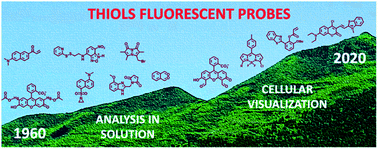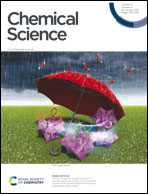The chronological evolution of small organic molecular fluorescent probes for thiols†
Abstract
Abnormal concentrations of biothiols such as cysteine, homocysteine and glutathione are associated with various major diseases. In biological systems, the structural similarity and functional distinction of these three small molecular thiols has not only required rigorous molecular design of the fluorescent probes used to detect each thiol specifically, but it has also inspired scientists to uncover the ambiguous biological relationships between these bio-thiols. In this minireview, we will discuss the evolution of small organic molecular fluorescent probes for the detection of thiols over the past 60 years, highlighting the potent methodologies used in the design of thiol probes and their particular applications in the semi-quantification of cellular thiols and real-time labelling. At the same time, the present challenges that limit their further application will be discussed. We hope that this minireview will promote future research to enable deeper insight into the crucial role of thiols in biological systems.

- This article is part of the themed collection: Most popular 2021 analytical chemistry articles, 2021


 Please wait while we load your content...
Please wait while we load your content...